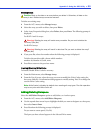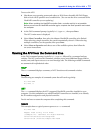
Appendix D: Using the AFU for DOS ● 72
To access the AFU:
1 Shut down your operating system and reboot to DOS from a bootable MS-DOS floppy
disk or from a DOS partition on a bootable drive. (You can use the drive connected to the
HostRAID controller you are updating.)
Note:
When updating the HostRAID controller flash, controller activity is not possible.
Before you can use the HostRAID controller again, complete the flash operation and restart
the computer.
2
At the DOS command prompt (typically A:\>) type
AFU,
then press Enter.
The AFU’s main menu is displayed.
3 Select Select Controllers, then select the Adaptec HostRAID controllers to be flashed.
When selecting a single controller, the system automatically selects it. When selecting
multiple controllers, use the spacebar, then press Enter.
4 Select Select an Operation and choose one of the available options, then follow the
on-screen instructions.
Running the AFU from the Command Line
At the DOS command prompt (typically A:\>), type
AFU
followed by a command and any
switches. The AFU processes the command, prompts you to insert additional floppy disks as
needed, exits, and reports success or an error message code. The following available commands
are summarized in alphabetical order.
HELP
The
HELP
command displays a summary of AFU functions and command switches.
Examples
The following are examples of command syntax that will work to get help:
A:\> AFU HELP
A:\> AFU /?
LIST
The
LIST
command displays the AFU-supported HostRAID controllers installed on your
computer. Use this command to see which HostRAID controllers are installed, or to identify
the ID numbers assigned to each physical controller.
You do not have to restart the computer after completing this command.
Example
This example shows a typical system response to a
LIST
command:
A:\> AFU LIST
Adaptec Flash Utility V1.0-0 B1406
(c)Adaptec Inc. 1999–2005. All Rights Reserved.
Controllers Detected and Recognized:
Controller #0 (03:01:00) Adaptec ASC-48300


















